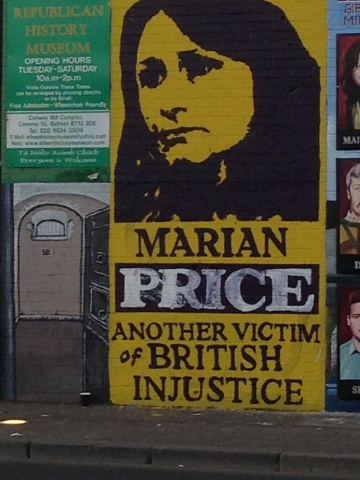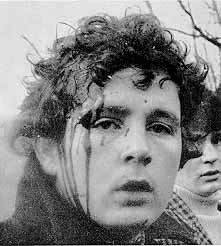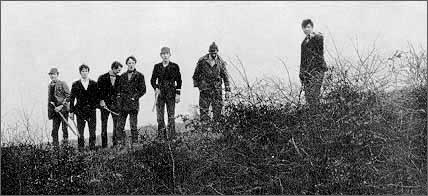Longing For Community
An Irish take on an Article by Carolyn Baker
An Irish take on an Article by Carolyn Baker
People use drugs, legal and illegal, because their lives are intolerably painful or dull. They hate their work and find no rest in their leisure. They are estranged from their families and their neighbors. It should tell us something that in healthy societies drug use is celebrative, convivial, and occasional, whereas among us it is lonely, shameful, and addictive. We need drugs, apparently, because we have lost each other - Wendell Berry
The Irish community is currently being ripped apart not just by its traditional enemy of Imperialism but also and addiction to drugs. In the last year Ireland lost one of its heroic resistance fighters Dolours Price not to British imperialism but to this current curse of the Irish community.The bedrock issue of longing for community contains remarkable success stories of how a community of individuals have come together to accomplish a milestone projects of support for each other in disaster. While our hearts are warmed by these stories, our hearts are more often broken by the litany of complaints about failed attempts to create community.
The history of inhabitants of English speaking Western civilization is founded on the individualism of characters like Horatio Alger and the male dominated neo-colonies of the British Empire which includes countries like Ireland and the current world super power theUSA . It is not necessary to list examples of indigenous communities where people have harmoniously lived together for thousands of years.
" What may be necessary, however, is to clarify the definition of community in order to modify our expectations and strive more realistically to achieve it.
It may be useful to first notice what community is not.
Community should not be narrowly defined as a group of people living together sharing space and resources. “Community” is not synonymous with “eco-village” although it can be.Community is not a context in which everyone must agree. A healthy community consists of diverse people and divergent opinions.
One’s community may be defined as a circle of close friends who over time have consistently given and received support. Likewise, a community may be a group of neighbors who care deeply about each others’ well being and who may or may not engage in community projects together. One may or may not have personal contact with the rest of the community on a regular basis but may be confident that if one is in need, the community will be there to provide support. The structure of some communities consists of an annual or semi-annual gathering in which members have face-to-face contact at those times with much more email or phone contact between gatherings.
For those readers seeking to inhabit or establish an eco-village, Diana Leafe Christian has written extensively about creating healthy living communities in her two remarkable books, Finding Community and Creating A Life Together. Her work offers magnificent tools for creating intentional communities and dealing effectively with conflict.
What I’m exploring here is not so much the exact structure of a community, but rather, the deeper sense of community that humans crave and create as a foundation for the literal manifestations of community they may ultimately devise. In other words, what does community mean to the soul, the psyche, the deeper self within us? If we do not attend to this aspect of community, for all of the ostensible successes the community may have achieved, its members may feel vaguely unsatisfied or in some cases, may divest their energy from the community and move on.
It is possible to be in agreement intellectually and philosophically on any number of issues but still not be connected. In fact, this may be one reason why many experiments in community fail. People are connected in a horizontal manner with one another, but they are not connected to the depths of something more profound and expansive than the individual ego. The issue that any community must address, consciously or unconsciously, is whether or not they desire to be connected on a soul level. In many communities such as a group of neighbors who are working together to eliminate litter and beautify their streets, the desire for soul-level connection may not be a priority. Their intention is highly focused and possibly time-limited.
In other contexts a community may consciously seek a connection with the depths. Invariably, this opens the way for intimacy through opening the heart not only to each other but to something greater than any individual or the group itself. However, a longing for connection with the depths is both enchanting and edgy because when people are interacting with one another, not to mention swimming in the depths together, they will invariably be triggered by their interactions and by whatever a connection with the deeper self evokes for them. This is another way of saying that when our hearts open, so does another part of us, the shadow.
The shadow is a word first used by psychologist Carl Jung to describe an unconscious part of the psyche that we disown or insist is “not me.” It consists of aspects of ourselves of which we are unaware—some of which may range from unequivocally repugnant to virtually angelic. A majority of communities fail because they do not grasp the necessity of doing shadow work or lack the skills for doing it. The shadow eventually emerges, or perhaps erupts, in all meaningful human relationships, and shadow work must be done both internally and externally whenever people are interacting or living in community.
When someone says or does something with which we feel some discomfort, we must check in with ourselves and first of all notice the feelings we experience—disappointment, anger, hurt, fear, or any other emotion. Before blaming the other person or becoming offended, it is useful to ask oneself what one’s own part in the interaction might be. For example: How might I have participated in creating this interaction? This requires an honest effort to look within and ponder the situation, and the answer may not come through the intellect. However, if we are willing to stay with the feelings and the question of “what is my part?” we may discover a significant piece of the shadow that is asking for our attention.
Usually, our first reaction when we experience a mis-communication or an uncomfortable exchange is to attempt to “fix” it by dialoging with the person(s) involved. While communicating directly with the other about the exchange may be necessary at some point, we rarely engage ourselves in the process first. That is to say, it is generally more useful to explore what is happening inside of ourselves first before dialoging further with the other person. We can do this by simply staying with the question: What is my part in this? To facilitate our exploration, we can journal about the interaction, we can utilize some form of art such as drawing or painting, or we can go more deeply within through meditation or some type of inner listening.
Whenever conflict arises, something is trying to be created within us and within the other person, or both. As our indigenous ancestors have always known, as painful as it may be, conflict should be welcomed as a wise teacher in our lives and our communities. Soul often generates conflict in order to create something more expansive and to empower us to become larger persons. Relationships without conflict are usually boring and lifeless whereas conflict in relationships breathes vitality and wisdom into the individuals involved, and if allowed, revered, and listened to, can transform a single life as well as an entire community.
The Earth Community
In our discourse on community we often omit the earth community as the principal ally, mentor, and role model for establishing and maintaining a community of human beings. David Korten, author of The Great Turning and Agenda For A New Economy contrasts the models of empire and earth community in his Yes Magazine article, “From Empire To Earth Community”:
We face a defining choice between two contrasting models for organizing human affairs. Give them the generic names Empire and Earth Community. Absent an understanding of the history and implications of this choice, we may squander valuable time and resources on efforts to preserve or mend cultures and institutions that cannot be fixed and must be replaced.
Empire organizes by domination at all levels, from relations among nations to relations among family members. Empire brings fortune to the few, condemns the majority to misery and servitude, suppresses the creative potential of all, and appropriates much of the wealth of human societies to maintain the institutions of domination.
Earth Community, by contrast, organizes by partnership, unleashes the human potential for creative co-operation, and shares resources and surpluses for the good of all. Supporting evidence for the possibilities of Earth Community comes from the findings of quantum physics, evolutionary biology, developmental psychology, anthropology, archaeology, and religious mysticism. It was the human way before Empire; we must make a choice to re-learn how to live by its principles.
In this reference to the earth community, Korten’s focus is on the model that the earth community provides humans who move away from hierarchical models toward partnership. Yet perhaps there is even more to glean from the earth community than the partnership model applied to human community.
Mathematical cosmologist, Brian Swimme prolifically writes and teaches the necessity of being in relationship with the earth community. What does this mean? According to Swimme:
What’s necessary is for us to understand that, really, at the root of things is community. At the deepest level, that’s the center of things. We come out of community. So how then can we organize our economics so that it’s based on community, not accumulation? And how can we organize our religion to teach us about community? And when I say “community,” I mean the whole earth community. That’s the ultimate sacred domain—the earth community.
What’s necessary is for us to understand that, really, at the root of things is community. At the deepest level, that’s the center of things. We come out of community. So how then can we organize our economics so that it’s based on community, not accumulation? And how can we organize our religion to teach us about community? And when I say “community,” I mean the whole earth community. That’s the ultimate sacred domain—the earth community.
How do you organize your technology so that as you use the technology, the actual use of it enhances the community? That’s a tough one. So long as we have this worldview in which the earth itself is just stuff, empty material, and the individual is most important, then we’re set up to just use it in any way we like. So the idea is to move from thinking of the earth as a storehouse to seeing the earth as our matrix, our fundamental community. That’s one of the great things about Darwin. Darwin shows us that everything is kin. Talk about spiritual insight! Everything is kin at the level of genetic relatedness. Another simple way of saying this is: Let’s build a civilization that is based upon the reality of our relationships. If we think of the human as being the top of this huge pyramid, then everything beneath us is of no value, and we can use it however we want. In the past, it wasn’t noticed so much because our influence was smaller. But now, we’ve become a planetary power. And suddenly the defects of that attitude are made present to us through the consequences of our actions.
A student of Thomas Berry, Swimme came to understand that the story of every human being parallels in some fashion, the story of the universe. For example Swimme notes:
Walt Whitman had an intuition about this when he said, ‘A leaf of grass is no less than the journeywork of the stars.’ And you think, how did he come up with that? Well, that’s called self-knowledge. In other words, a star gave birth to the elements that then assembled themselves in the form of Walt Whitman. So you could say that Walt Whitman had a deep memory of where he came from.
Likewise, when Einstein discovered the general theory of relativity, he discovered it from within. There was no data on the expansion of the universe or anything else. He said he just went into his own visceral movements—a strange way of thinking about creativity—and he paid attention to what was going on within, and he gave birth to the gravitational equations we use now. This is what I think Whitman did. He penetrated the depth of his own bodily reality and had this intuition about stars. And we’ve now discovered the empirical details about this. I just love that—everybody comes out of the stars.
What then is the soul of community?
It is a desire to be connected with something greater than the egos of other people and the projects in which we might engage with them. Fundamentally, a successful human community is the unfolding of a spiritual dynamic. It cannot be contrived or made to happen. Rather, it erupts from our desire for the depths, and that desire is certain to constellate the shadow in ourselves and the other. If we follow our longing for community, we must be prepared to do our own shadow work and support others as they do theirs. Ultimately, we touch the soul of community when we savor our own personal story as the story of the universe and the earth community. The journey of authentic community is also a journey of healing which is guaranteed to take us deep into the inner world of our own demons and angels as well as those in the psyches of our community companions. For as Wendell Berry notes, “To be healed we must come with all the other creatures to the feast of Creation.”
While all of this may sound tedious and laborious, and in fact it often is, the potential rewards are too momentous to ignore—being genuinely seen and lovingly held by the human and more than human community. Argue as we may that that would be too good to be true, fundamentally, this is the soul of community, and something in us refuses to stop longing for it.
Carolyn Baker, Ph.D., was an adjunct professor of history and psychology for 11 years and a psychotherapist in private practice for 17 years. (She is not, and never has been, a licensed psychologist.) Her latest book Sacred Demise: Walking The Spiritual Path of Industrial Civilization’s Collapse, is unique in its offering of emotional and spiritual tools for preparing for living in a post-industrial world. Carolyn’s forthcoming book is Navigating The Coming Chaos: A Handbook For Inner Transition. Her other books include: Coming Out From Christian Fundamentalism: Affirming Sensuality, Social Justice, and The Sacred (2007) , U.S. History Uncensored: What Your High School Textbook Didn’t Tell You (2006) and The Journey of Forgiveness, (2000) All may be purchased at this site. She is available for speaking engagements and author events and can be contacted atcarolyn@carolynbaker.net . Her blog is http://carolynbaker.net "



 Wednesday March 06, 2013 08:32
Wednesday March 06, 2013 08:32 by Brian Clarke - AllVoices
by Brian Clarke - AllVoices



.jpg)






